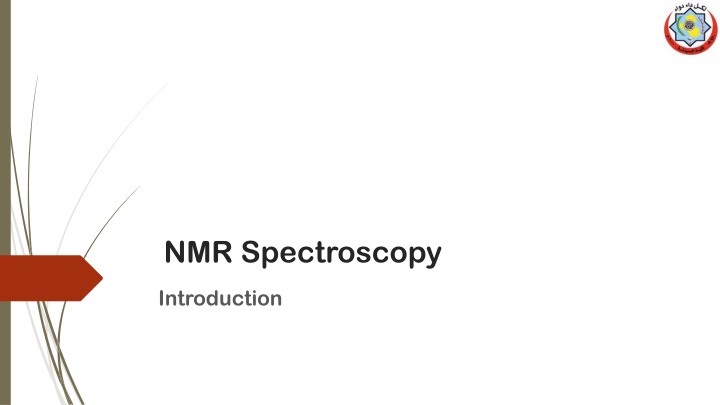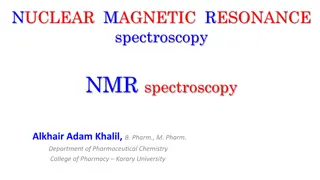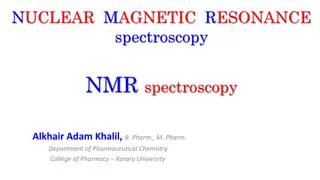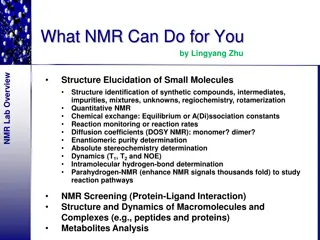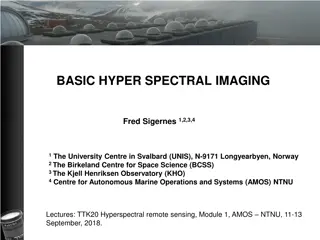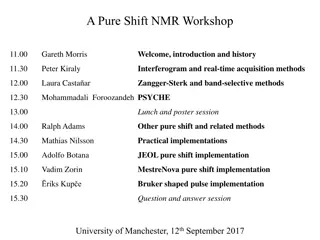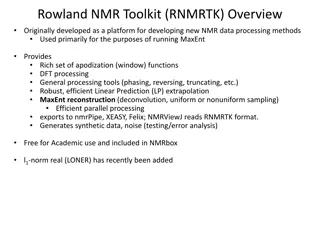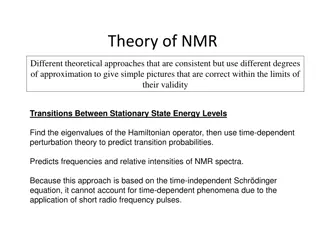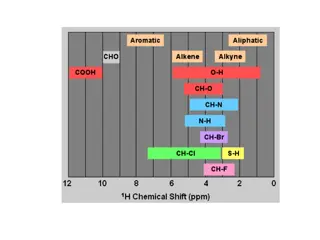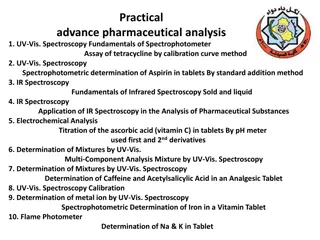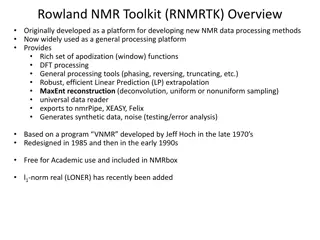Introduction to NMR Spectroscopy
Nuclear magnetic resonance (NMR) spectroscopy is a powerful analytical technique used to characterize organic molecules by identifying carbon-hydrogen frameworks. Learn about the physical background, active nuclei, and energy principles behind NMR.
Download Presentation

Please find below an Image/Link to download the presentation.
The content on the website is provided AS IS for your information and personal use only. It may not be sold, licensed, or shared on other websites without obtaining consent from the author.If you encounter any issues during the download, it is possible that the publisher has removed the file from their server.
You are allowed to download the files provided on this website for personal or commercial use, subject to the condition that they are used lawfully. All files are the property of their respective owners.
The content on the website is provided AS IS for your information and personal use only. It may not be sold, licensed, or shared on other websites without obtaining consent from the author.
E N D
Presentation Transcript
NMR Spectroscopy Introduction
Introduction to NMR Spectroscopy 2 Nuclear magnetic resonance spectroscopy is a powerful analytical technique used to characterize organic molecules by identifying carbon-hydrogen frameworks within molecules. Two common types of NMR spectroscopy are used to characterize organic structure: determine the type and number of H atoms in a molecule; 13C NMR is used to determine the type of carbon atoms in the molecule. The source of energy in NMR is radio waves which have long wavelengths, and thus low energy and frequency. When low-energy radio waves interact with a molecule, they can change the nuclear spins of some elements, including 1H and 13C. 1H NMR is used to
Introduction to NMR Spectroscopy 3 When a charged particle such as a proton spins on its axis, it creates a magnetic field. Thus, the nucleus can be considered to be a tiny bar magnet. Normally, these tiny bar magnets are randomly oriented in space. However, in the presence of a magnetic field B0, they are oriented with or against this applied field. More nuclei are oriented with the applied field because this arrangement is lower in energy. The energy difference between these two states is very small (<0.1 cal).
NMR Active Nuclei 4 Most elements possess at least one NMR active nucleus, but many of them several (i.e.,115Sn, 117Sn and 119Sn, 95Mo and 97Mo, etc.). In order for an atom to be NMR active: Odd number of neutrons or protons. If it is even, the spin quantum number will be zero. Both 12C and 16O will not be observable, but 13C, 1H and 17O are NMR active nuclei. The spin quantum number (I) must not equal zero, i.e, I = ( ). Nuclei with a spin quantum number larger than I= ( ) often show broad lines because of their quadrupole moment
NMR Active Nuclei 5 There is a significant difference in abundance in these NMR active nuclei and the sensitivity of these experiments differs quite a bit as well. Spin Quantum Number, I Magnetogyric ratio, g (107 rad T-1s-1) 26.7519 4.1066 28.535 Natural Abundance NMR Active Nucleus Protons Neutrons 1H 2H 3H 12C 13C 14N 15N 16O 17O 19F 31P 99.985 % 0.015 % trace 98.89 % 1.11 % 99.6 % 0.37 % 99.76 % 0.04 % 100 % 100 % YES YES YES NO YES YES YES NO YES YES YES 1 1 1 6 6 7 7 8 8 9 0 1 2 6 7 7 8 8 9 10 16 1 0 1 0 5 2 6.7283 1.934 -2.712 -3.62808 25.181 10.841 15
Physical Background of NMR Spectroscopy I 6 Energy mI= - E= f( Bo)= h mI= + Increased magnetic field Bo The principle behind NMR is that many nuclei have spin and all nuclei are electrically charged. If an external magnetic field is applied, an energy transfer is possible between the base energy to a higher energy level (generally a single energy gap). The energy transfer takes place at a wavelength that corresponds to radio frequencies and when the spin returns to its base level, energy is emitted at the same frequency. The signal that matches this transfer is measured in many ways and processed in order to yield an NMR spectrum for the nucleus concerned.
aligned against the field ENERGY = = h aligned with the field A spinning nucleus such as 1H behaves as a spinning charge and generates a magnetic field. It can be likened to a bar magnet. When it is placed in an externally applied field it can align with, or against, the field. The energy difference between the two states (DE) depends on the applied field.
Physical Background of NMR Spectroscopy II 8 A resonance phenomenon occurs when the aligned nuclei interact with the applied field and are forced to change their spin orientation The energy, which is absorbed, is equal to energy difference DE between the two spin states. This resonance energy is about 10-6 kJ/mol (the radio-frequency) The stronger the applied field, the greater energy difference between the spin states (DE) becomes, which allows distinguishing even between very similar atoms The NMR spectrometers with stronger magnetic fields provide better resolution 60 MHz 600 MHz 0.80 1.10 1.00 0.70 0.90 0.60 0.80 0.50 0.70 0.60 0.40 0.50 0.30 0.40 0.30 0.20 0.20 0.10 0.10 0.00 3.5 3.0 2.5 2.0 1.5 1.0 0.5 0.0 0.00 3.5 3.0 2.5 2.0 1.5 1.0 0.5 0.0
Physical Background of NMR Spectroscopy II 9 The strength of the magnetic field determines the range of frequencies that must be used. Most spectrometers employ three chambers to achieve this low temperature; The innermost chamber contains liquid helium, (b.p 4.3K). Surrounding by a chamber of liquid nitrogen (b.p 77) K). The third and outermost chamber is a vacuum that minimizes heat transfer from the environment. Any heat developed in the system is transferred from the liquid helium to the liquid nitrogen. In this way, the innermost chamber can be maintained at 4 degrees above absolute zero. This extremely cold environment enables the use of superconductors that generate the large magnetic fields required in NMR spectroscopy.
Physical Background of NMR Spectroscopy III 10 The exact resonance frequency of a certain nucleus depends on the environment of the nucleus. The effective magnetic field is a result of the applied magnetic field and the changes that are induced by the environment Heff= Ho Ho The changes are often summarized into a shielding constant, . = o B = dia+ para+ neighbor+ medium 1 ( ) 2 The larger the shielding constant and the smaller the effective field, the higher the applied field has to be in order for the nucleus to resonate as constant frequency (=shift to lower d-values in the 1H-NMR spectrum) If a constant magnetic field is applied, the resonance frequency will decrease with increasing shielding In 1H-NMR spectroscopy, the diamagnetic and neighboring effects are the most important contributions because only s-orbitals are important In 13C-NMR, the paramagnetic term becomes more significant because of the involvement of p-electrons
11 An intense, homogeneous and stable magnetic field (magnet + shim) A probe which enables the coils used to excite and detect the signal to be placed close to the sample High-power RF transmitter/s capable of delivering short pulses (RF source + RF Amplifier) A sensitive receiver to amplify the NMR signals (RF Detector) A Digitizer to convert the NMR signals into a form which can be stored in computer memory A pulse programmer to produce precisely timed pulses and delays A computer to control everything and to process the data
Type of NMR Spectroscopy 12 Continuous wave NMR Spectroscopy Varying the frequency of radiation at constant magnetic field and measuring the absorption of radiation by the different nucle FT NMR Spectroscopy (better resolution and sensitivity) In FT-NMR all nuclei are excited at the same time by a radio frequency pulse. Radio frequency pulse : if the radiation is emitted as a very short pulse. A short radio frequency pulse contains many frequencies in a broad band around 0.
Solvents in NMR spectroscopy 13 If the solvent itself has protons, the spectrum will be overwhelmed with signals from the solvent, rendering it unreadable. As a result, solvents without protons must be used. Although there are several solvents that lack protons, such as CCl4, these solvents do not dissolve all compounds. In practice, deuterated solvents are generally used. The deuterium atoms are invisible to the NMR spectrometer, why??? Ans. A 300-MHz spectrometer will use a pulse that consists only of frequencies between 300,000,000 and 300,005,000 Hz. The frequencies required for deuterium resonance do not fall in this range.
Types of NMR Tubes 15 Solution NMR Sample Tube Spinners Solid State Sample Rotors NMR Sample Tubes with Caps
NMR Sample Preparation 16 5 mm Use clean + dry NMR tubes and caps (tubes can be re-used, caps should not!) 0.5 ml deuterated solvent (i.e. CDCl3 ,C6D6 , acetone-d6 ,etc.) substrate requirements for routine spectra: 10 mg for proton NMR 100 mg for carbon-13 NMR min. filling height of tube: 2 inches (5 cm) 3 6 6 Cleaning of tubes: 1. rinse with solvent you were using 2. rinse with acetone 3. dry in (vacuum-)oven at low temperature
NMR Sample Preparation 17 Suspension or opaque solution Not enough solvent Concentration gradient Clean clear solution Precipitate Two phases GOOD! B a d S a m p l e s !
Interpretation of NMR spectra 18 The spectrum produced by 1H NMR spectroscopy is generally rich with information that can be interpreted to determine a molecular structure: number of different signals in the spectrum position of the signals (chemical shift) intensity of the signals splitting pattern of the signals Obtaining spectra a liquid sample is placed in a tube which spins in a magnetic field solids are dissolved in solvents which won t affect the spectrum - CCl4, CDCl3 TMS, tetramethylsilane, (CH3)4Si, is added to provide a reference signal when the spectrum has been run, it can be integrated to find the relative peak areas spectrometers are now linked to computers to analyse data and store information
Tetramethylsilane TMS (provides the reference signal) 19 The molecule contains four methyl groups attached to a silicon atom in a tetrahedral arrangement. All the hydrogen atoms equivalent. are chemically non-toxic liquid - SAFE TO USE inert - DOESN T REACT WITH COMPOUND BEING ANALYSED has a low boiling point - CAN BE DISTILLED OFF AND USED AGAIN all the hydrogen atoms are chemically equivalent - PRODUCES A SINGLE PEAK twelve hydrogens so it produces an intense peak - DON T NEED TO USE MUCH signal is outside the range shown by most protons - WON T OBSCURE MAIN SIGNALS given the chemical shift of d = 0 the position of all other signals is measured relative to TMS
